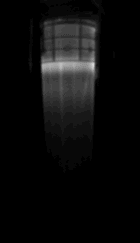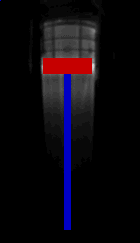
 Applications of WAY-2C extend beyond simple color sensing.
During the startup of the U.S. Department of Energy's joint campaign with the
Westinghouse subsidiary-West Valley Nuclear Services, WAY-2C was used
as part of the U.S. Congress approved nuclear waste
cleanup program near Buffalo, NY called the West Valley Demonstration Project.
Applications of WAY-2C extend beyond simple color sensing.
During the startup of the U.S. Department of Energy's joint campaign with the
Westinghouse subsidiary-West Valley Nuclear Services, WAY-2C was used
as part of the U.S. Congress approved nuclear waste
cleanup program near Buffalo, NY called the West Valley Demonstration Project.
When pouring began in July 1996, a WAY-2C based system was monitoring
the solidification of the molten radioactive glass as it filled
the 10-foot tall stainless steel canisters, approved for high level waste
at the West Valley Demonstration Project site.
On the left is a thermal infrared image of a canister into which
molten radioactive glass is being poured. On the right is an
interpretation of that image generated by CTIMS (Canister Thermal Image
Monitoring System) a WAY-2C based software system. Red designates the region which the system
interprets as currently hot. The blue region indicates the portion of the
canister which has been hot in the past. Output from the WAY-2C
interpretation is used to generate a 4-20ma control signal proportional to the
highest level in the canister at which hot melt is now or previously has been observed.
John Victor, who was a Senior Engineer at Westinghouse-WVNS,
and inventor and developer of this concept from it's inception in 1990,
references the WVNS Trade Publication document
"Powering Down at West Valley".
"It was September 5, 2002 when the Vitrification
Melter was powered down forever, after completing
a successful campaign of filling 275 canisters.
The real good news for us as a team, was that the
total number of canisters predicted was well over 300.
Because of our efforts, the Infrared Level Detection System
allowed the WVDP to save over 34 canisters at an estimated
saving far exceeding one million dollars per canister.
Due to the accuracy of
and confidence in the Infrared Level data, they were able
to fill the canisters over 90 percent on average, which far
exceeded the minimum DOE requirement of 80 percent fill."
|

